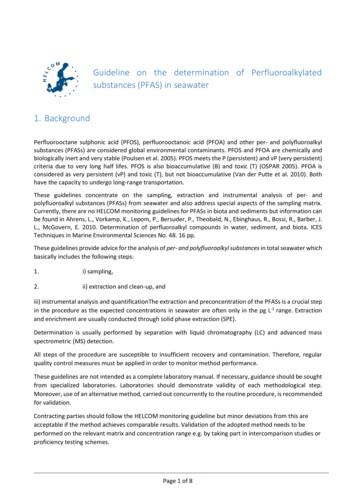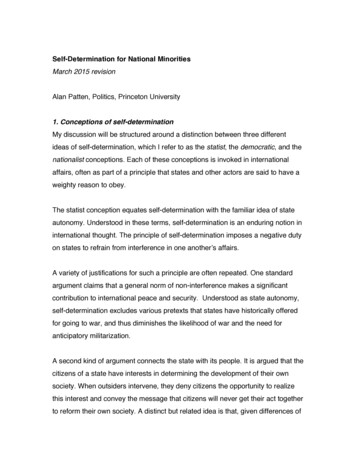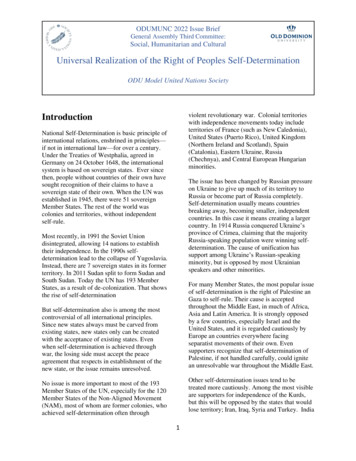
Transcription
Guideline on the determination of Perfluoroalkylatedsubstances (PFAS) in seawater1. BackgroundPerfluorooctane sulphonic acid (PFOS), perfluorooctanoic acid (PFOA) and other per- and polyfluoroalkylsubstances (PFASs) are considered global environmental contaminants. PFOS and PFOA are chemically andbiologically inert and very stable (Poulsen et al. 2005). PFOS meets the P (persistent) and vP (very persistent)criteria due to very long half lifes. PFOS is also bioaccumulative (B) and toxic (T) (OSPAR 2005). PFOA isconsidered as very persistent (vP) and toxic (T), but not bioaccumulative (Van der Putte et al. 2010). Bothhave the capacity to undergo long-range transportation.These guidelines concentrate on the sampling, extraction and instrumental analysis of per- andpolyfluoroalkyl substances (PFASs) from seawater and also address special aspects of the sampling matrix.Currently, there are no HELCOM monitoring guidelines for PFASs in biota and sediments but information canbe found in Ahrens, L., Vorkamp, K., Lepom, P., Bersuder, P., Theobald, N., Ebinghaus, R., Bossi, R., Barber, J.L., McGovern, E. 2010. Determination of perfluoroalkyl compounds in water, sediment, and biota. ICESTechniques in Marine Environmental Sciences No. 48. 16 pp.These guidelines provide advice for the analysis of per- and polyfluoroalkyl substances in total seawater whichbasically includes the following steps:1.i) sampling,2.ii) extraction and clean-up, andiii) instrumental analysis and quantificationThe extraction and preconcentration of the PFASs is a crucial stepin the procedure as the expected concentrations in seawater are often only in the pg L-1 range. Extractionand enrichment are usually conducted through solid phase extraction (SPE).Determination is usually performed by separation with liquid chromatography (LC) and advanced massspectrometric (MS) detection.All steps of the procedure are susceptible to insufficient recovery and contamination. Therefore, regularquality control measures must be applied in order to monitor method performance.These guidelines are not intended as a complete laboratory manual. If necessary, guidance should be soughtfrom specialized laboratories. Laboratories should demonstrate validity of each methodological step.Moreover, use of an alternative method, carried out concurrently to the routine procedure, is recommendedfor validation.Contracting parties should follow the HELCOM monitoring guideline but minor deviations from this areacceptable if the method achieves comparable results. Validation of the adopted method needs to beperformed on the relevant matrix and concentration range e.g. by taking part in intercomparison studies orproficiency testing schemes.Page 1 of 8
1.1 IntroductionPFOS and PFOA are members of the larger family of per- and polyfluoroalkyl substances (PFASs). PFOSprecursor can degrade to PFOS, also called PFOS-related compounds. Some 100–200 PFOS-relatedcompounds have been identified (KEMI 2006, Buck et al 2011). Table 1 provides an overview of PFAS that areenvironmentally relevant in water and provides information on chemical names, acronyms, formula, andChemical Abstracts Service (CAS) numbers, as well as suggestions for suitable isotopically labelled internalstandards for use in PFAS analysis.Table 1. List of possible perfluoroalkyl substances to be monitored in water and their isotopically labelledinternal tePerfluorobutane sulfonatePerfluorohexane OOC4F9SO2OC6F13SO2O-Perfluorooctane sulfonatePFOSC8F17SO2O-6:2 fluorotelomer sulfonate6:2FTSA O2N(C2)CH2CO2HPerfluorooctane ic acidINTERNAL 1,2,3,4,5,6,7,813C8)octanesulfonate6:2 fluorotelomer sulfonate [13C8]-PFOS[13C2]-6:2 FTSA[13C8]-FOSAPage 2 of 8)F17SO2NH2n.a.n.a.n.a.n.a.n.a.n.a.n.a.
N-deuterioethylperfluoro-1octanesulfonamidoacetic acidd5-N-EtFOSAAC8F17SO2N(C2D5)CH2CO2Hn.a.The individual compounds belong to the following compound groups: perfluoroalkyl sulfonates (PFSAs),perfluoroalkyl carboxylates (PFCAs), perfluorooctane sulfonamides (FOSAs), and perfluorooctanesulfonamidoacetic acids (FOSAAs). For monitoring purposes, the chemicals PFOS, PFOA, C4-C12 PFCAs, C4,C6, C8 PFSAs and FOSA are considered to be the most important PFASs. Although most studies have focusedon PFOS and PFOA, it is suggested that PFAS with longer and shorter carbon chain lengths should also beincluded in the analysis. Long‐chain PFAS ( C8) should be included because of their potential tobioaccumulate and to adsorb onto sediment. Perfluorobutane sulfonate (PFBS) and perfluorobutanate(PFBA), the short‐chain substitutes of PFOS and PFOA, should preferentially be monitored in water as theymay bioaccumulate to a lesser extent.The presence of PFAS in seawater samples provides information on the contaminant load of parts of theBaltic Sea. At the moment monitoring is coordinated nationally. Poland, Lithuania and Germany monitorPFOS concentrations in seawater in their national monitoring program.1.2 Purpose and aimsThe aim of monitoring PFASs is to identify their spatial variations and temporal trends in seawater.2. Monitoring methods2.1 Monitoring featuresThe main focus of monitoring is surface waters ( 5 meters) of coastal and open sea waters.2.2 Time and areaMonitoring covers the entire Baltic area, and is performed throughout the year.2.3 Monitoring procedure2.3.1 Monitoring strategyThe analysis of PFAS in seawater generally includes solid-phase extraction (SPE) and liquid chromatography(LC) with mass spectrometric (MS) detection.2.3.2 Sampling method and equipmentWhen analyzing PFASs from biologically active samples, it is highly recommended to extract the water sampleas soon as possible after sampling without further manipulation, e.g. seawater samples should not betransferred into further containers before extraction. It is recommended to take, preserve and handlesamplesasspecifiedinISO5667-1.Materials and clothes that contain, or may adsorb, fluorinated compounds, such as polytetrafluoroethylene(PTFE), must be avoided during sampling and sample processing. In particular, the containers that come intodirect contact with the sample must not contain any fluorinated polymers (e.g. PTFE). Containers andequipment made of polypropylene (according to ISO 25101:2009), polyethylene, glass, or stainless steelshould be used. However, especially glass and polypropylene sampling and storage containers should becarefully checked for PFAS, as longer chained PFASs tend to sorp to glass walls, and cleaned before use (e.g.the sample container or filtration equipment must be rinsed with a polar solvent, such as methanol and driedbefore use) in order to minimize contamination. Every material that may come into contact with the samplePage 3 of 8
must be free of fluorinated compounds. The highest contamination risk was observed for PFOA andperfluorononanate (PFNA; Theobald et al., 2007).2.3.3 Sample handling and analysisFor the extraction of total water samples (sum of dissolved and particulate phase), no pre-treatment isnecessary. But in order to avoid blocking of the solid‐phase extraction (SPE) cartridges for water samples witha high content of suspended particulate matter, a filtration step might be necessary. Filtration can be doneon GF/F glass fiber filter or with syringe nylon membrane filter. As flat-bed filters have a very limited capacity,the use of coiled glass fiber filter is recommended for volumes larger than 10 l and water samples with highamounts of suspended matter. A pump is necessary to force the water through the filter. Due to theadditional steps, this operation affords a number of additional quality control measures (adsorption losses,contamination problems) as the filtration equipment may be a source of contamination (Ahrens et al., 2009b;Arp and Goss, 2009).Samples should be spiked with internal standards (see Table 1) before extraction, at concentrations close tothe environmental level, in order to correct for losses during extraction and concentration, and for matrixeffects during analysis.When extraction cannot be done within a few days after sampling, water samples should be stored at 20 C, because biotransformation of (biologically degradable) polyfluoroalkyl substances may occur inbiologically active samples (Huset et al., 2008), and be analysed within two weeks (ISO, 2009).Blanks and contaminationCare should be taken to avoid contaminations during sampling, extraction and analysis.Concentrations of PFAS in seawater are very low. In order to minimize the risk of sample contamination,sample treatment and processing should be carried out on a clean bench or in a clean room containing nofluorinated compounds (e.g. PTFE) and it is strongly recommended to pretreat all used glassware andadsorption material.A blank should be analysed within each sample batch. If measurable blanks occur, the analyticalinstrumentation and every sample preparation step must be checked for contamination and appropriatemeasures taken before continuation of analysis. Reporting of samples with measurable blanks should beconsidered carefully.Extraction and clean-upLarge‐volume injection can be used to analyse PFAS directly without sample pretreatment (Schultz et al.,2006) if concentrations in the samples are high enough with the advantage that no further clean‐up isrequired and eluates may be analysed directly or after being concentrated to 1 ml.The most commonly applied method for the extraction of PFAS from seawater samples with lowconcentration is SPE (Moody and Field, 1999, Taniyasu et al., 2008; ICES, 2010). A pH adjustment is usuallynot necessary for water samples before extraction, but it may improve the recoveries for some PFAS,depending on the matrices and target compounds (Van Leeuwen et al., 2006). For SPE extraction the use ofOasis WAX (Weak Anion eXchange) cartridges (Waters Corporation, Milford, MA) is recommended, accordingto the ISO standard 25101 (ISO, 2009;) and ICES, 2010. For large volumes (2-10 l) StrataX 33u PolymericReversed Phase cartridges (Phenomenex, 1 g/ 12 ml Giga Tubes) are recommended.Page 4 of 8
Instrumental analysisLiquid chromatography coupled with a tandem mass spectrometer and interfaced with an electrosprayionization source in negative‐ion mode (LC/( )ESI‐MS/MS; Hansen et al., 2001) and LC coupled with an ESIquadrupole time‐of‐flight mass spectrometer (LC/ESI‐QTOF‐MS) have both been used for PFAS analysis(Berger and Haukas, 2005). Tandem MS and QTOF‐MS have the advantage of providing low signal‐to‐noiseratio and high selectivity on low concentrations.Chromatographic determinationThe C 8 or C 18 reversed‐phase columns may be used for the LC separation of PFAS. The use of a guard columnis recommended in order to maintain chromatographic performance and extend the lifetime of thechromatographic column. To overcome separation problems (e.g. co‐eluting matrix compounds), it may behelpful to use reversed‐phase columns with polar groups instead of C 8 or C 18 columns. Mixtures of waterand either methanol or acetonitrile can be used as the mobile phase, in each case with 2 – 10 mM ammoniumacetate as an ionization aid. Gradients ranging from 10 % to 100 % methanol or acetonitrile are required forthe separation of the compounds listed in Table 1. To ensure stability of retention times, the use of atemperature‐controlled column oven is recommended.For solvents, use of PFAS trapping column is highly recommended as it delays analyte peaks originating fromeluents (Stone et al. 2010).Mass spectrometryThe most widely used technique for detection of PFAS in tandem MS (MS/MS) operated is multiple reactionmonitoring (MRM) mode. Mass spectrometry parameters, such as collision energy, clustering potential, andcone voltage, must be optimized for each individual compound and each instrument. The sensitivity of triplequadrupole MS is usually approximately one order of magnitude higher than that of QTOF-MS or QTOFMS/MS (Berger et al., 2004).3. Data reporting and storageData is reported annually to the HELCOM COMBINE database, hosted by ICES. Data must be flagged as forHELCOM Combine.4. Quality control4.1 Quality control of methodsQuality assuranceA number of measures should be taken to ensure sufficient quality of the analysis. Six main areas can beidentified:a) extraction efficiency and clean-up;b) calibrant and calibration;c) system performance;Page 5 of 8
d) long-term stability;e) internal standards; andf)frequent participation in interlaboratory proficiency testing schemes and analysis of certifiedreference materials (CRM). At the moment only proficiency testing schemes for PFAS in sedimentbiota, or drinking water are offered, but not for seawater. Reference materials are available for PFASin water and fish.a) Extraction efficiency and clean-upThe use of internal standards is recommended in order to take any losses or matrix effects into account. Forthe determination of the recovery rates of the clean-up and concentration steps, it is recommended to passa standard solution through the entire procedure. If major losses have occurred, the results should not bereported.b) Calibrant and calibrationCalibration solutions should be stored in ampoules at a cool, dark place. Weight loss during storage shouldbe recorded for all standards. Risk of contamination during the storage must be monitored and suitableampoules used.For PFAS determination calibration solutions from certified PFAS solutions should be used. When using aPFOS standard solution of mixed isomers, it should be determined whether the nominal concentrationcorresponds to the linear PFOS or to the total amount of isomers (Kaupmees & Rebane, 2017).System performanceThe performance of the LC system can be monitored through regularly analyzing the resolution of two closelyeluting compounds. A decrease in resolution indicates deteriorating LC conditions.The signal-to-noise ratio of a low-concentration standard gives information on the condition of the detector.For example, a dirty MS-source can be recognized by the presence of a higher background signal, togetherwith a reduced signal-to-noise ratio.c) Long-term stabilityOne laboratory reference sample should be included in each series of samples. A quality control chart shouldbe recorded for selected PFAS compounds. If warning limits are exceeded, the method should be checkedfor possible errors and the obtained sample results should not be reported.d) Internal standardsInternal standards should be added to all standards and samples either in a fixed volume or by weight andshould not interfere with the target analytes.A number of mass-labelled PFAS compounds were proven to be suitable for LC-MS analysis (Table 1).4.2 Quality control of data and reportingMeasurement uncertainty should be estimated using ISO 11352:2012 or according to the Nordtest reportTR537. Estimation should be based on within-laboratory reproducibility, data from proficiency tests, IRM,and, when available, CRM.Data must be flagged if normal QA routines or recommended storage conditions cannot be followed.Page 6 of 8
5. Contacts and references5.1 Contact personsBerit Brockmeyer, Federal Maritime and Hydrographic Agency (BSH), Germany5.2 ReferencesAhrens, L., Plassmann, M., Xie, Z., and Ebinghaus, R. 2009. Determination of polyfluoroalkyl compounds inwater and suspended particulate matter in the River Elbe and North Sea, Germany. Frontiers ofEnvironmental Science and Engineering in China, 3: 152 – 170.Arp, H. P. H., and Goss, K‐U. 2009. Gas/particle partitioning behavior of perfluorocarboxylic acids withterrestrial aerosols. Environmental Science and Technology, 43: 8542 – 8547.Berger, U., and Haukas, M. 2005. Validation of a screening method based on liquid chromatographycoupled to high‐resolution mass spectrometry for analysis of perfluoroalkylated substances in biota. Journalof Chromatography A, 1081: 210 – 217.Berger, U., Langlois, I., Oehme, M., and Kallenborn, R. 2004. Comparison of three types of massspectrometer for high‐performance liquid chromatography/mass spectrometry analysis ofperfluoroalkylated substances and fluorotelomer alcohols. European Journal of Mass Spectrometry, 10: 579– 588.Buck, R.C., Franklin, J., Berger, U., Conder, J.M., Cousins, I.T., de Voogt, P., Jensen, A.A., Kannan, K., Mabury,S.A., van Leeuwen, S.P.J 2011. Perfluoroalkyl and Polyfluoroalkyl Substances in the Environment:Terminology, Classification, and Origins. Integr Environ Assess Manag. 2011 Oct; 7(4): 513–541.Huset, C. A., Chiaia, A. C., Barfosky, D. F., Jonkers, N., Kohler, H‐P. E., Ort, C., Giger, W., Field, J. A. 2008.Occurrence and mass flows of fluorochemicals in the Glatt Valley watershed, Switzerland. EnvironmentalScience and Technology, 42: 6369 – 6377.ICES - Ahrens, L., Vorkamp, K., Lepom, P., Bersuder, P., Theobald, N., Ebinghaus, R., Bossi, R., Barber, J. L.,McGovern, E. 2010. Determination of perfluoroalkyl compounds in water, sediment, and biota. ICESTechniques in Marine Environmental Sciences No. 48. 16 pp.ISO. 2009. Water quality – Determination of perfluorooctanesulfonate (PFOS) and perfluorooctanoate(PFOA) – Method for unfiltered samples using solid phase extraction and liquid chromatography/massspectrometry. International Organization for Standardization, ISO 25101:2009 (TC 47/ SC 2). 19 pp.Kaupmees, S., Rebane, R. 2017. Analysis and validation of perfluorinated compounds in water, sedimentand fish with LCESI–MS/MS International Journal of Environmental Analytical Chemistry, Vol. 97, No. 8,695–709 https://doi.org/10.1080/03067319.2017.1356922.KEMI 2006. Perfluorinated substances and their uses in Sweden. Swedish Chemical Agency (KEMI) Report7/06. 58 pp.Moody, C. A., and Field, J. A. 1999. Determination of perfluorocarboxylates in groundwater impacted byfire‐fighting activity. Environmental Science and Technology, 33: 2800 – 2806.OSPAR 2005. OSPAR background document on perfluorooctane sulphonate. 46 pp. OSPAR Commission.Updated in 2006.Poulsen, P., Jensen, A., Wallström, E. 2005. More environmentally friendly alternatives to PFOS-compoundsand PFOA. Environmental Project No. 1013. Danish Environmental Protection Agency. 162 pp.Schultz, M. M., Barofsky, D. F., and Field, J. A. 2006. Quantitative determination of fluorinated alkylsubstances by large‐volume‐injection liquid chromatography tandem mass spectrometry‐characterizationof municipal wastewaters. Environmental Science and Technology, 40: 289 – 295.Stone, P.K.W., Cote, L., Gushue, J., Letcher, R.J., Chu S. 2010. Agilent App. Note, 5990Page 7 of 8
Taniyasu, S., Kannan, K., Yeung, L. W. Y., Kwok, K. Y., Lam, P. K. S., and Yamashita, N. 2008. Analysis oftrifluoroacetic acid and other short‐chain perfluorinated acids (C2 – C4) in precipitation by liquidchromatography–tandem mass spectrometry: Comparison to patterns of long‐chain perfluorinated acids(C5 – C18). Analytica Chimica Acta, 619: 221 – 230.Theobald, N., Gerwinski, W., Caliebe, C., and Haarich, M. 2007. Development and validation of a method forthe determination of polyfluorinated organic substances in sea water, sediments and biota. Occurrence ofthese compounds in the North and Baltic Seas. Umweltforschungensplan des Bundesministeriums furUmwelt, Naturschutz, und Reaktorsicherheit, Forschungsbericht 202 22 213, UBA‐FB 00 001409. 133 pp. (inGerman, with English abstract)Van der Putte, I., Murin, M., Van Velthoven, M., Affourtit, F. 2010. Analysis of the risks arising from theindustrial use of Perfuorooctanoic acid (PFOA) and Ammonium Perfluorooctanoate (APFO) and from theiruse in consumer articles. Evaluation of the risk reduction measures for potential restrictions on themanufacture, placing on the market and use of PFOA and APFO. RPS Advies B.V. 82 pp. annexes.van Leeuwen, S. P. J., Kärrman, A., Van Bavel, B., De Boer, J., and Lindström, G. 2006. Struggle for quality indetermination of perfluorinated contaminants in environmental and human samples. EnvironmentalScience and Technology, 40: 7854 – 7860.5.3 Additional literatureAhrens, L., Vorkamp, K., Lepom, P., Bersuder, P., Theobald, N., Ebinghaus, R., Bossi, R., Barber, J. L.,McGovern, E. 2010. Determination of perfluoroalkyl compounds in water, sediment, and biota. ICESTechniques in Marine Environmental Sciences No. 48. 16 pp.Page 8 of 8
Page 1 of 8 . Guideline on the determination of . Perfluoroalkylated substances (PFAS) in seawater . 1. Background . Perfluorooctane sulphonic acid (PFOS), perfluorooctanoic acid (PFOA) and other per- and polyfluoroalkyl










